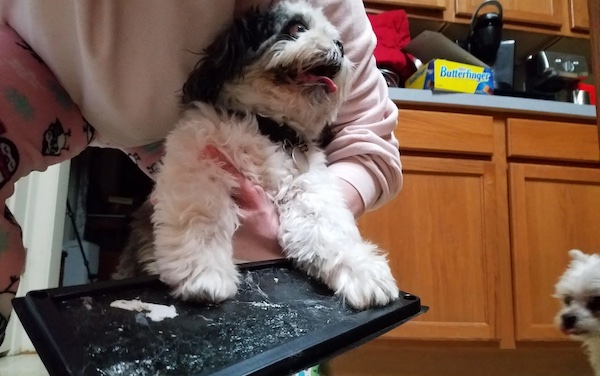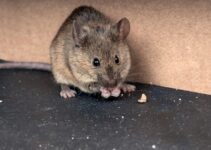The adhesives on sticky mouse traps are not poisonous. However, when they contain the remnant of a dead and disposed mouse, your dog risks exposure to bacteria or viral infection.
Beyond this, all you should be worried about is your dog’s fur, nose, and mouth getting stuck.

Are Sticky Mouse Traps Poisonous to Dogs?
Sticky or glue traps are not poisonous to dogs. However, they should be used and dumped (properly) after every capture because there are certain threats associated with your dog touching the trap:
Getting stuck: Dogs sniff a lot and may sniff their way to a glue trap if there is food on it. In an attempt to smell or eat the food, their fur may get stuck. This may also lead to their nose and mouth getting stuck.
If it is just the fur, it can be separated with scissors. When the nose and mouth are involved, you need vegetable oil to release the dog.
Exposure to bacteria and viral infections: It is wrong to reuse a glue trap. This is because they usually contain remnants such as peeled skin, torn limbs, or feces. These elements can easily expose your dog to bacteria and viral infections.
What Should I Do If My Dog Licked A Glue Trap?
It is usually not a big deal if a dog licks a glue trap. However, it may become worrisome if he or she consumes a huge quantity or is exposed to mice remnants.
Such dogs may start wheezing or pacing restlessly. While this may be very rare, there are symptoms to watch out for over the next hours. They include:
- Intestinal blockage and choking (very common)
- Lethargy – extreme fatigue or tiredness
- Abdominal swelling
- Glazed eyes
- Inability to pass stool
- Stomach pain
- Vomiting
- Loss of appetite
The best course of action is to contact your vet or transport the dog to the nearest veterinary clinic. If the glue is still in your dog’s throat, your vet may recommend giving him or her milk to dilute the adhesive and induce vomiting.
Bland diets have also proven to work for dogs suffering from stomach or intestinal blockage. Feeding them to your dog for the next few days will keep your intestine surrounded and aid in the easy passage of foreign material.
Pumpkin paste, skinless (boiled) chicken or lean best, boiled potatoes, or boiled rice are bland diets that can protect against intestinal blockage.
You can also provide Pepcid-AC 10 mg tablets to your pet every 12 hours to reduce stomach acid production. This prevents inflammation and relieves the digestive tract.
Note: These remedies must be recommended or endorsed by a vet before you proceed.
How to Release Dog Stuck on Glue Trap Using Vegetable Oil
Releasing a dog from a glue trap requires patience and care. The steps involved include:
- Get your protective gloves, vegetable oil, and medicated shampoo in place.
- Wear your gloves and use a vet-prescribed sedative or tranquilizer to calm the dog completely. If your dog is the very obedient type, he or she may not need to be sedated.
- Apply the vegetable oil to the stuck part and surrounding area, and massage gently. After a few minutes of massage, the adhesive should become weak enough for you to release your dog.
- Once your dog is safe, wash him or her with a medicated shampoo to remove traces of oil or glue. This refreshes the dog as well.
- Wash your hands and dispose of the gloves used.
- The dog’s body language will tell you the next course of action between rest and food. Most times, the dog prefers to rest first.
Note: An alternative to vegetable oil is baby oil or petroleum jelly. They may not be as quick in action as vegetable oil but they will get the job done.
Wrap-up
Glue traps are harmless to dogs in most cases. However, when they consume a huge part of the adhesive or get exposed to mice remnants, you must study their reaction within the next few hours.
This is one of the downsides to glue traps and another reason why they are not the safest way to kill or control mice. Pet owners using glue traps are strongly advised against it or should restrain their pets from where they are located.
References
- https://www.humanesociety.org/resources/glue-boards
- https://animals.mom.com/how-to-remove-a-glue-trap-from-a-pet-6738243.html
- https://www.midwaypestmanagement.com/post/are-mouse-traps-dangerous-to-small-dogs
- https://learnaboutpet.com/are-sticky-mouse-traps-poisonous-to-dogs/
- https://insectcop.net/how-to-remove-mouse-trap-glue/





